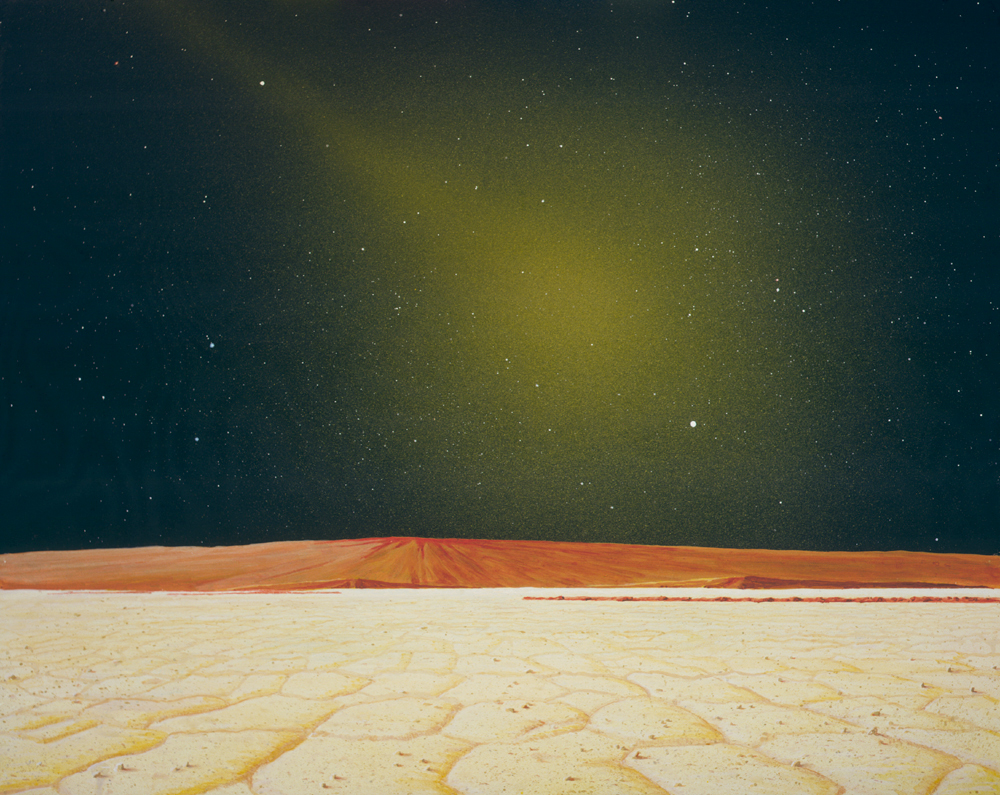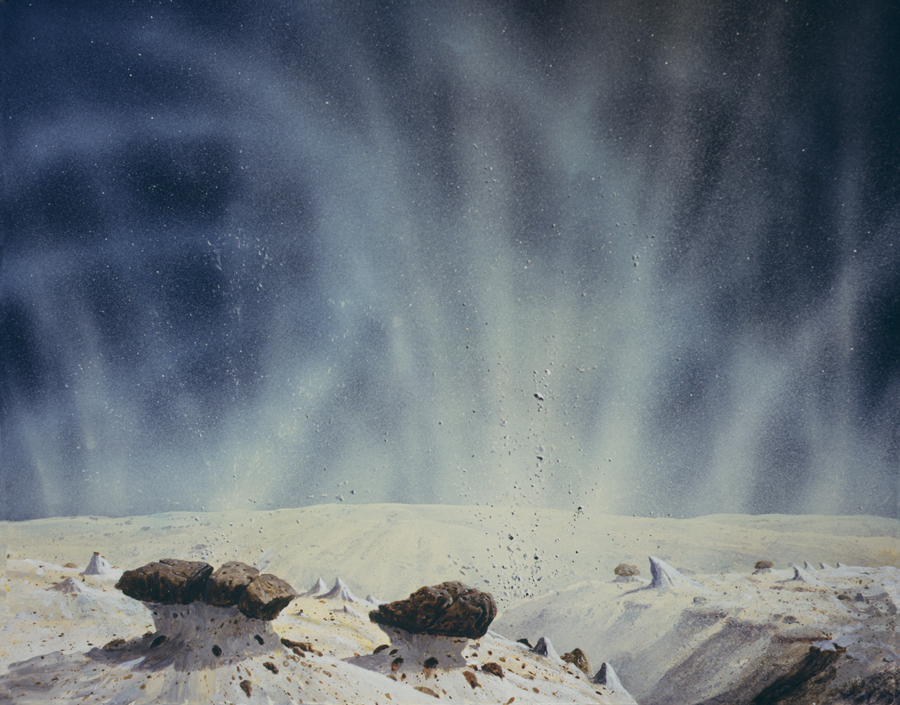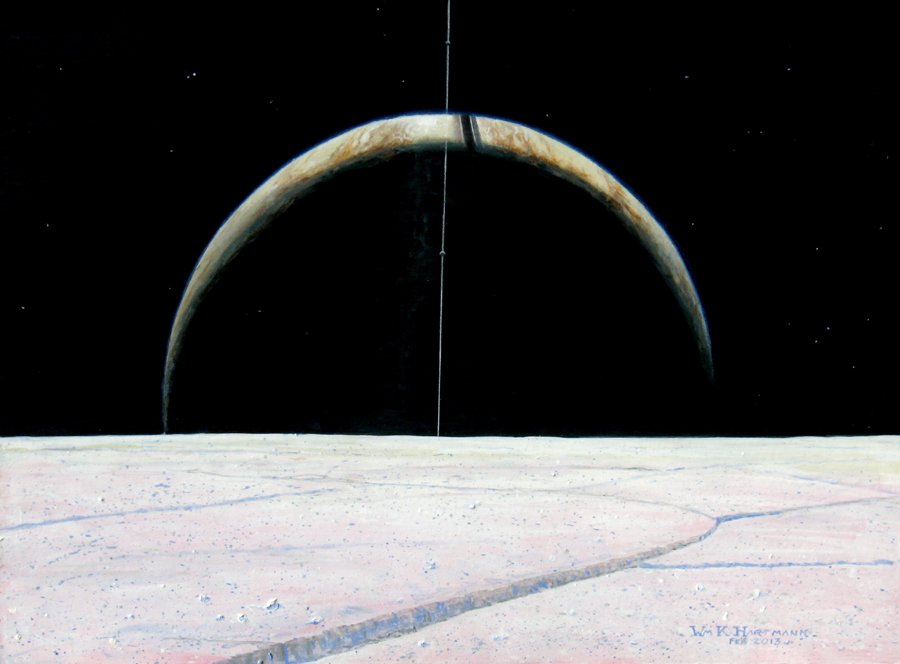Science & Art: How Astronomical Artists Learn To See
- Published: Monday, November 25 2013 18:16
BY WILLIAM K. HARTMANN, PLANETARY SCIENCE INSTITUTE, TUCSON, ARIZONA

Caption: “Formation of Terrestrial Planets”. The origin of planets in the primordial solar system. The view shows the late stages of the dusty nebula, and aggregating planetesimals near the plane of the disk. The largest foreground object is developing an extended atmosphere of degassing volatiles. Gas jetting away from the disk is seen around the sun. (Copyright William K. Hartmann).
Learning to “see,” to sense what things really look like, raises a subordinate question. To make a painting of a tree should you walk over to the tree and take some samples of leaves and bark, take them back to your studio, and pick the tube of green paint that exactly matches the color of the leaf or the bark? No. Why not? There are several reasons. How an object looks depends on the light source and our own light receptors. Ask yourself: how is it that we can walk into a museum and see a good landscape painting across the room and know that it represents a cloudy winter day, a summer day, a night scene, etc. Direct sunlight hitting a surface from a clear blue sky contains a lot of reds and oranges (which explains why red and orange flowers are bright on a clear day. The same surface light under that same sky in the shade gets light only from the blue sky which explains why shadows on snow in a sunny day are blue. Light coming through a heavy overcast sky loses many of the warm and pure blue colors makes the same surfaces a more dull blue-gray. To add another effect, the red receptors of the eye are less sensitive under low light levels, and at many early painters of the early west, such as Frederick Remington expressed moonlit views) landscapes in greenish-bluish-grey tones that immediately give a sense of night vision.
One could, of course, deliberately make paintings of what things might look like to a camera or alien observer sensitive to other wavelengths than we are. Thinking about such issues, I decided that in most of my paintings I would to render what a human observer would see if he/she were transported to various cosmic locations.
Alan Bean, who actually walked on the moon during Apollo 12 (and is a Fellow of the IAAA), has become the most sought-after painter of lunar scenes, and he wrestles with a different issue. If you select grey pigments that are anything like the actual colors of lunar rocks, you end up with a rather dull painting. Yet I have heard astronauts describe surface were they landed as looking bright like “an Alpine ski valley.” This is a contrast effect; the same effect as standing under a very bright streetlight at midnight in an asphalt parking lot — the ground around you looks pretty bright! Bean, a fan of Monet, followed path of the French impressionists. Far from being dreamy aesthetes, as often portrayed, the impressionists were interested in mid-19th century studies of the solar spectrum, and the fact that sunlight (unlike pigment which we see by reflected light) contain the whole rainbow of bright colors. So the impressionists experimented with using dabs of various colors that, to some extent, can give impressions of natural light, or even grey surfaces, when seen all together. Bean’s lunar paintings often contain a myriad of pastel tones that create lunar greys that contrast with the still lighter tones he puts in the “white” suits of his astronaut figures.

Caption: “Sodium Glow in the Sky”. My 1980 view of the sodium-glow torus of Io, as seen from the Io surface. The torus extends around Jupiter in Io’s orbit. In this view we are looking in the anti-solar direction along torus and orbit path, and the torus is seen curving away in the distance. The glow is brightest when Io is moving toward or away from the sun in its orbit. (Copyright William K. Hartmann).
So, again, the introduction of the human observer in a specific setting emphasizes that there may be many ways of rendering that scene, dependent on the lighting and the setting, independent of any issues about “mood” or “emotional content.”
Another quite different issue that intrigues me as a painter is one of our problems in astronomy, and especially planetary science: we’ve broken our natural phenomena into too many constituent aspects. Here’s an example. 19th century astronomers separated fuzzy comets from star-like asteroids, most 20th century astronomers maintained the distinct categories, merely because of semantic and instrumental differences. Comet observers were mostly gas spectroscopists who went to one set of meetings, while asteroid observers tried categorize the mineralogy of the bare rocky surfaces they saw, and went to different meetings. Thanks to Fred Whipple and others, people began to realize that comets had solid, ice-rich, “geological” bodies as nuclei, so in 1981 I attempted a painting of the such a surface (Fig. 5), based on a synthesis of all that I knew, including Steve Larson’s then-emerging high-resolution images of individual jets within comet comas, and my own observations of ice forms at 14,000 feet on Mauna Kea. I took it to a Tucson comet meeting and asked for critiques. The most interesting result was that most attendees seemed never to have tried to what a comet’s “geological” surface might look like to human observers; their horizons were limited by their scientific techniques.

Caption: “Comet Surface With Eruption”. My 1981 attempt to render the possible appearance of the surface of a comet nucleus. The view shows jets of material issuing from fissures, and the “toadstool” formations I thought might form when bits of dark, carbonaceous crust were left stranded on ice pedestals as the icy matrix sublimes away. Later, Dale Cruikshank, Dave Tholen, Johan Degewij, and I, working at Mauna Kea, made probably the first determination that comet nucleus albedoes are around 4%, and correctly predicted this value for Halley’s comet. (Our suggestion was criticized until the Giotto probe measured a 4% albedo on that object!). (Copyright William K. Hartmann).
As an amusing sidelight, I noticed on Mauna Kea that volcanic cinders were sometimes thrown from roads or upper slopes onto icy snow fields. The combination of sublimation and melting from sunlight lowered the snowfield, but the cinders were left perched in small toadstool-like pedestal formations because they shielded the underlying ice from the sun as surrounding ice sublimed and/or melted in the sun. Thinking this process might work as an active comet loses volatile mass, I put several of the toadstools, capped by black carbonaceous rocks, in my comet painting. Within a year I noticed that my toadstools began to show up in other comet paintings, including several mission design concept illustrations from the Jet Propulsion Lab. Around the same time I was told by a colleague that he had submitted a short paper to a journal, with photographs of similar formations, suggesting they might evolve on comet surfaces, but he said the paper was rejected by referees who argued that photos of natural ice phenomena on Earth could have nothing to do with comets.
My favorite question — “how would the object we are studying look to a human being” thus forces us to expand the phenomenology we think about, and expand our awareness of what our data mean. To take another example; a good friend of mine obtained the first direct observations of the sodium emission-line “aurora” around Jupiter’s satellite Io. He gave the discovery talk at a meeting, and announced a measured surface brightness in units of “kilorayleighs,” I asked him after the talk whether that number of kilorayleighs would be visible to the human eye if one were on, or near, Io. My friend had no idea. Don Hunten, based on his studies of aurora and airglow, thought the answer was yes, so, in 1980, I made what I think was the first painting showing a scene on Io, looking along the yellow sodium-glow torus in the sky (Fig. 6) What amazed me in this episode was that an astronomer spent half a year or so of his life quantitatively measuring a phenomenon, yet had no idea of whether it could be perceived by a human being. Again, it suggests to me that we are too detached from the natural world that we claim to study.
As a result of such experiences, I’m inclined to think you can’t really claim to understand something if you can’t draw a picture of it, or at least imagine a picture of it. My favorite mental exercise when I start an astronomical painting is to consider the subject as a place rather than an object of study, and then ask: “What would this place look like to a human being?” Thus, process of painting an astronomical painting with a paintbrush and real paint, not with commercial digital — art software — forces you to confront what we know and what we don’t know about nature.

Caption: “Saturn Seen From Enceladus”. “Plane” geometry as seen from Saturn’s moon Enceladus. In this 2013 painting, my idea was to create the simplest possible geometric pattern and still be scientifically realistic. The view is from a flat ice plain (and plane) on Enceladus’s equator, with the rings of Saturn extending vertically and the sun backlighting the scene. The sun is just off-axis from the rings (hence the ring shadow on the ball of the planet) and I added some fractures on the ice plane to add a touch of asymmetry. (Copyright William K. Hartmann).
To summarize, I once remarked that my idea of astronomical painting is to create beautiful images out of our new knowledge of the universe. The idea of “beauty” brings us back to the human element. In a way, then, I think painting is a way to allow my science to be not about dispassionate observations, hypotheses, and models, but to bring my humanity into my science in a way that fecundates new ideas and new responses.
William Hartmann is a fellow with the International Association of Astronomical Artists.







Comments